Traveling Egypt
From the Nile to the Sinai
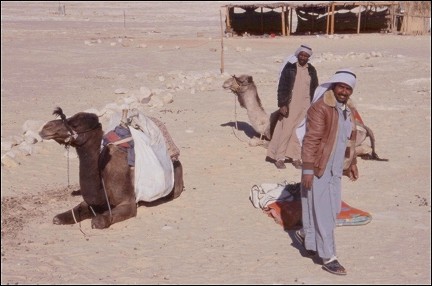
|
A tour of Aswan and surroundings, where thousands of years old temples were relocated for the construction of a dam; Abu Simbel; a boat ride by felouka on the Nile river; the royal tombs in Luxor; snorkling in the Red Sea; and a tour on camelback along Biblical locations and oases in the Sinai Desert.
Travelogue & photos: Peter van Boheemen
Aswan and surroundings
Thousands of years old temples were relocated
We stay in Aswan for two days. The city has a lively market, where we replenish our wardrobe: our luggage was lost during our flight to Egypt.
In the afternoon we visit the Aswan dam. The place is crowded with soldiers and police. I have never been in a country with so much security.
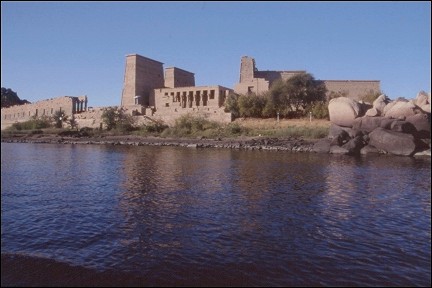
|
For security reasons it's also not allowed to videotape the Aswan dam. Taking pictures is allowed. The Aswan dam keeps the Nile under control. Lake Nasser, which was created by the dam, is the largest artificial lake in the world.
Thouands of years old, monumental temples had to be relocated to prevent them from drowning in the rising waters. One of those landmarks is the Kalabsha temple. It was moved 50 kilometers north in 1970. We are taken there by boat. Where there are temples in Egypt, there are also tourists. Droves of them.
Abu Simbel
Dozens of tourist coaches arrive at the same time
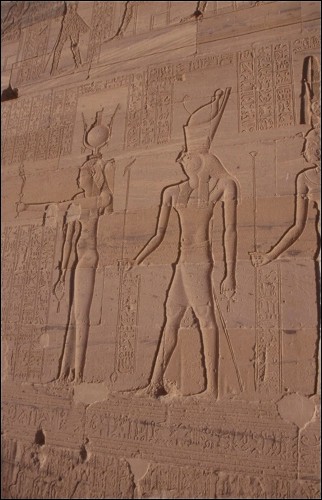
|
At 3 AM we are ready for our bus ride to Abu Simbel. We end up in a bus with French people. At the Aswan dam the many vans and even more touringcars have to check in with the policeman on duty.
After the assault on tourists in Luxor, in 1997, in which 52 people were killed, security has been enormously increased in tourist places. That is why the buses have to drive in column.
But after they are out of sight of the police, every bus driver tears away. That way, the 275 kilometers throug desolate desert are soon behind us.
Driving in column has a downside: the dozens of touringcars all arrive at the same time in Abu Simbel. When we arrive, we find ourselves in a huge crowd with only two ticket booths. Experienced guides elbow themselves to the tickets booths to get dozens of tickets for themselves and their colleagues.
It all but gets to blows. You have to wonder if you want to be part of this. But anyway, after some cursing, we get our tickets.
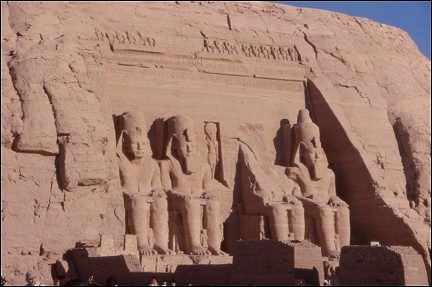
|
But the craziness at the booths is more than compensated by the view of the 33 meters high ancient Egyptian façade.
Next to the enormous Ramses statues is a small temple which was built in honor of Nefertari, the favorite wife of Ramses II. That Ramses had more than one wife is clear from the fact that he had around 53 sons and 76 daughters.
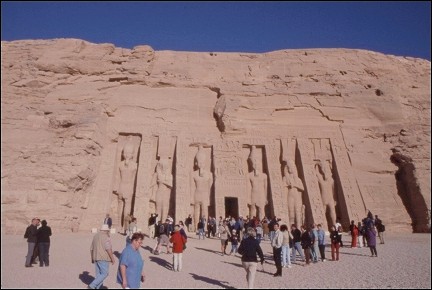
|
Ramses had a lot of time to achieve things during his reign: although the average lifespan for Egyptians in the 13th century BC was only 35 - 40 years, Ramses II reached the age of 93.
Ramses' mummified body now is in the Egyptian Museum in Cairo.
This temple was also moved because of the rising waters in Lake Nasser. The Unesco had it sawed in pieces and reassembled 210 meters inland in an artificial rock wall at 65 meters above its original location in 1960.
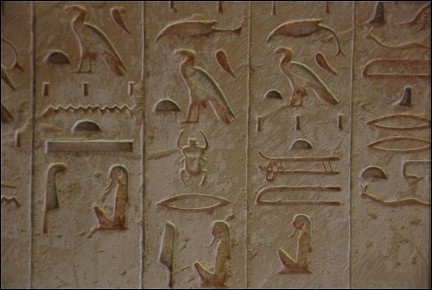
|
We shuffle into the temple with the crowd. The hieroglyphics are clearly visible. But to see some of the statues over the mass of video cameras, you have to stand on your toes.
"No flash, no flash," the guards call out. But they don't have a lot of authority. People use their flashes anyway. As interesting as this temple is, this tourist craziness is too much for me.
Felouka tour
About 240 cruiseships sail between Aswan and Luxor
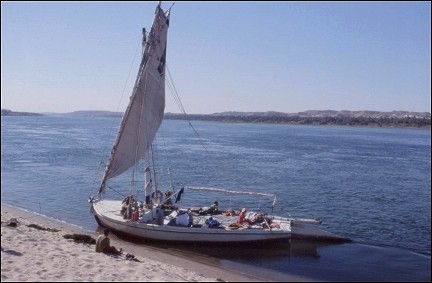
|
After the touristic hustle and bustle we take a felouka tour. This is a traditional Egyptian sail ship of which there are many on the Nile. There are also many cruiseships: just between Aswan and Luxor there are about 240 of those.
The felouka begins its tour at Aswan. We visit Kitchener Island. The British colonel Horatio Kitchener was awarded the island after he led a successful campagne of the Egyptian army against Sudan. He planted exotic plants and trees from all over the world in it and now we can enjoy the botanic gardens there.
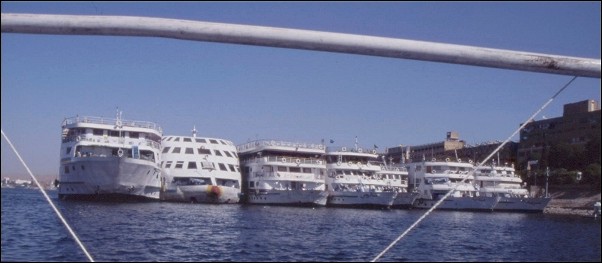
Some passengers leave the ship in the afternoon; eight passengers remain who want to experience two nights on the boat. It is an international company: two Brazilian ladies, one Indonesian, one Thai, an American/Japanese couple and us, two Dutch.
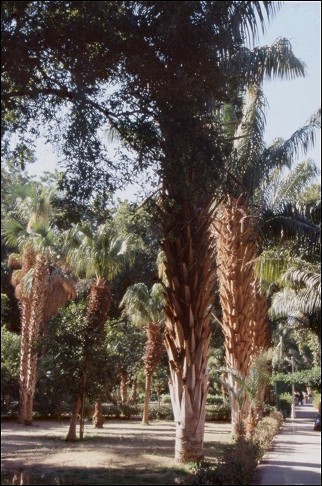
|
Slowly it gets colder on the water. We even have to put on our coats. When we dock on a beach it gets better. The captain cooks dinner: a mix of macaroni, potatoes and tomato sauce. After dinner it's only 6 PM. And it's December 31...
So we'll have to wait for 6 hours, until midnight, to wish one another a happy new year. The captain says he can get beer and a joint. I order three beers. The Brazilian girls prefer a joint. And the captain hasn't said too much: he succeeds in acquiring all these goodies.
We enjoy them around a campfire. A creaking cassette recorder plays Arabic music. The captain dances to it (stoned?). The beer is gone to quickly. But just before the midnight tea is ready. So we wish each other Happy New Year with a glass of tea in our hands.
And then we go to sleep. That isn't easy. The captain has brought too few and too thin blankets. His own solution is to lie down next to one of the Brazilian ladies. But she has no use for a horny Arab next to her. The same happens with his second attempt: the Thai girl isn't interested either, so he wanders off to his cabin without a blanket, for a sleepless night.
After breakfast the warm morning sun keeps everyone horizontal on deck. In the afternoon, it gets even warmer, while the felouka leisurely sails on the Nile.
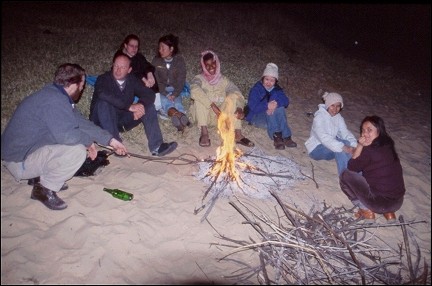
|
As pleasant as the temperatures are in the daytime, at night it gets freezing cold again. Everyone turns in at 8 PM. I try to withstand the cold for a while, staring at the stars and passing cruiseships.
But then I go to sleep. I keep my coat on. It helps, but my feet are still lumps of ice. The temperature decreases to 5 degrees Centigrade.
At the break of dawn the captain picks up his paddle and we move again, until he docks his felouka between some large cuiseships and we are on land again. We take our leave of the captain and his boat. He unabashedly asks me why I don't give him a tip, so I tell him I am not happy after two freezing cold nights. It was his responsibility to provide enough blankets. The American in our company is also very clear: "No blankets, no tips."
More temples in Luxor
Dozens of tombs and burial chambers
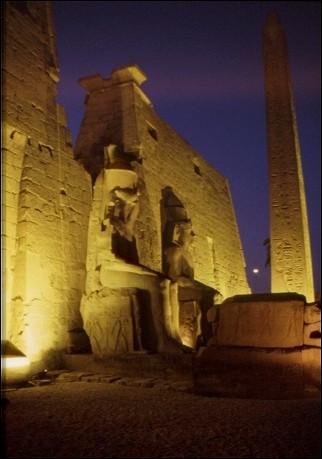
|
A van takes us to Kom Ombo. There we visit a small temple, together with many other tourists. Afterwards, the van takes us to the Horus temple in Edfu. This one is really impressive. Especially the pylon with reliefs about pharao Ptolemaeus.
We continue on to Luxor where the luxury of a hotel is waiting for us. We can finally take a shower and the few clothes we have, go to the laundry service.
In the evening we visit the mummification museum. One of the exhibits is a skull cut in two, filled with cloth.
The Luxor Museum which we visit the next day is also nice. Its many sculptures are exhibited widely and well-organized. The highlight is a beautiful, gilded head of the cow-goddess Hathor.
Luxor is the tourist center of Egypt. The crowds may be unbearable at times, but you are a tourist who wants to see everything as well, aren't you? So we also take the tour of Karnak with its Amon temple.
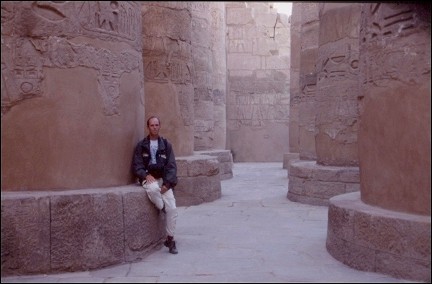
|
I am most impressed with the large hypostyle hall. Its roof was supported by 134 columns. The roof is gone, but the columns are still there. If the columns hadn't been this big, they would undoubtedly have been overrun by tourists by now.
It is hard to avoid the crowds, because almost everyone is in a tour group and follows their guides, stopping all at the same time in the same spot. When the guides are done talking, there often is enough room to get a good and unhurried look at the exhibits.
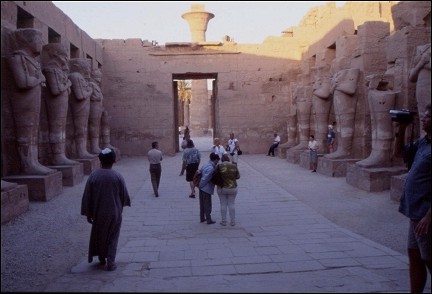
|
Back in Luxor we visit the Luxor temple. It's dark now, which makes the Luxor temple even more beautiful, because it is wonderfully illuminated. Again a breathtaking row of columns; the impressive sphinx promenade is also worthwhile.
Today we visit the Valley of the Kings and Queens. The valleys are majestically located between the remote limestone hills. There are dozens of tombs and burial chambers; until today new tombs are discovered. There are many "celebrity" tombs in the Valley of the Kings, like Tutanchamon's.
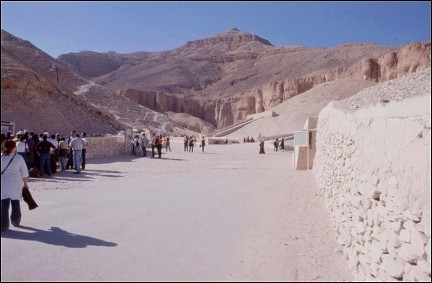
|
To protect the tombs, you are only allowed to visit three of them. You get three tickets and can decide for yourself which ones you want to see. But some are temporarily closed. The guide tells a lot about the tombs. It's hard to follow his rapid English.
The often brightly colored hieroglyphics are the most striking features of many burial chambers.D
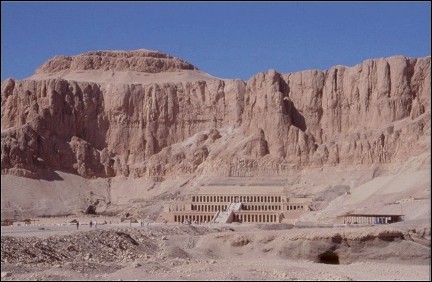
|
After also having visited the Valley of the Queens we continue on to the Hatshepsut temple. Its location against a limestone wall is again so impressive that we are already sure it will be interesting to visit the landmark.
Queen Hatshepsut was a female sovereign. Many of her statues were destroyed by later pharaos. They probably considered the female pharao a blasphemy and tried to erase this piece of Egypt's past from history. Obviously they didn't succeed. Some statues portray Hatshepsut with a beard and without breasts. She probably ordered this for political reasons.
The Red Sea
Aquarium fish in all colors surround you
Enough culture for now. We take the evening bus from Luxor to Hurghada. A taxi takes us from the bus terminal to a hotel. Upon arrival we are immediately invited to a meal of sea fish. We end the day in a local bar.
Early in the morning the cook knocks on our door: our omelets are ready. Today we go snorkling in the Red Sea. A diving school provides diving goggles and flippers. A boat is waiting for us in the port to take us to a coral reef.
There is a lot to see underwater. Lots of fish that you usually only see in aquariums swim around us. It's very pretty. But the water isn't very warm, especially because you don't move a lot when you are snorkling. Back on the boat it takes a while for me to warm up. I don't join the others for a second round.
In the evening we visit the "Dutch Bar". It's lively, but too Western. So later we return to the Cowboy Bar which has a more indiginous atmosphere. Although it's weird to call a bar in a Muslim country "typically Egyptian".
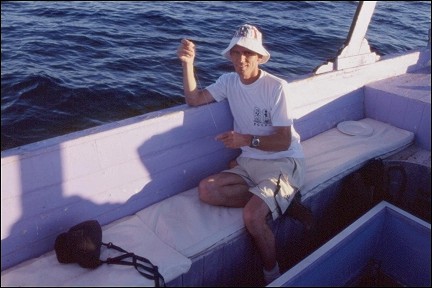
|
We spend another day in Hurghada. We go fishing for half a day. In the afternoon we leave on a boat. The captain gives us fishing lines with hooks. We attach pieces of squid, throw out the lines and wait. But we wait and wait, but hardly catch anything.
The captain doesn't give us any instructions, even though he apparently knows how it's done: he catches fish. We can keep the fish we caught and bring it to the Cowboy Bar, where it will be cooked for us. It is a meagre meal, because the cook says he can only fillet the largest fish. But, I have to admit, it's perfectly cooked.
The Sinai Desert
Trudging on camelback through a desolate landscape
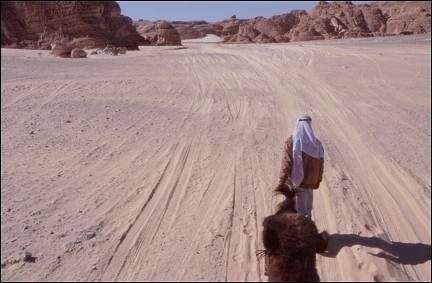
|
The ferry from Hurghada to Sharm El-Sheikh leaves at 8 AM. It hurries over the Red Sea in on and a half hour. A taxi takes us to Dahab, a hundred kilometers farther.
This turns out to be a tropical surprise. Beaches, palm trees, cozy hotels, restaurants where you can lounge, and idyllic music in the background provide a relaxed atmosphere.
At 11 PM a van picks us up to take us to the foot of Mount Sinai where we will see the sunrise tomorrow morning. Mount Sinai has a biblical history. Moses is supposed to have received the ten commandments here.
We begin our hike at the St.Catherine Monastery. The temperature is pleasant. Because our driver stepped on it, we are earlier than most other tourists. Soon people drop out of the hike. They are picked up by camel owners and continue on their tour on camelback.
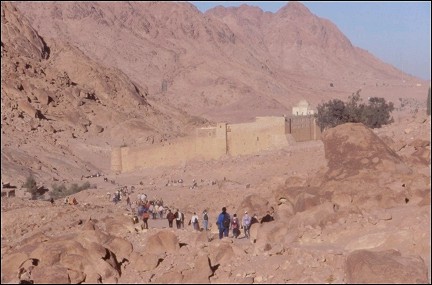
|
As soon as I lag behind because of a sanitary stop, the camel drivers get hopefull: "Camel, Sir! Camel, Sir!" No, thanks, I'd rather walk. The path isn't very steep and is easy to walk on.
The last part consists of 700 steps. With help of flashlights we find them all. We are among the first to arrive at the top. When we look down, we see the whole hairpin path illuminated by flashlights. Again, we are not alone.
With our rented blankets we find a level spot where we can sleep until dawn. When the sun almost appears over the mountains, we have to make sure we don't lose our territory to pushing video tourists.
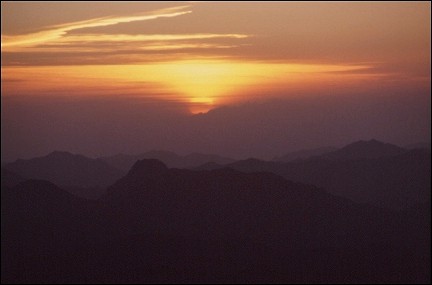
|
Sunrise is beautiful but not spectacular. We can go back now. After a little patience, we pass large tourist groups on our way down.
We are back at the beginning, the St.Catharine Monastery. There we wait until we are allowed in. We are in the first group that gets permission to enter. Inside there is more biblical history: the burning bush, supposedly a shoot from the original bush from which God spoke to Moses and commanded him to lead his people to the promised land.
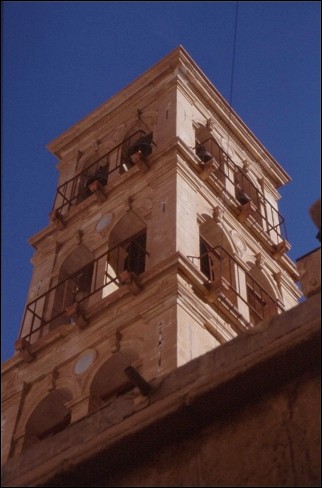
|
Other hightlights are the many icons and the belltower from 1871, donated by Czar Alexander. Remarkable is the mosque inside the monastery. It was founded in 1106 to appease the local Muslim rulers.
After leaving the monastery, we pay a short visit to the charnel house where the bones and skulls of monks who died over the centuries are kept.
We return to Dahab. The chauffeur drives again like an idiot. Still we arrive in one piece.
We take it easy for the rest of the day: we are still sleepy after a sleepless night.
The next morning we leave for a desert safari. A van with a civilized driver takes the two of us to two men and their camels. We get on our camels and trudge through the desolate landscape.
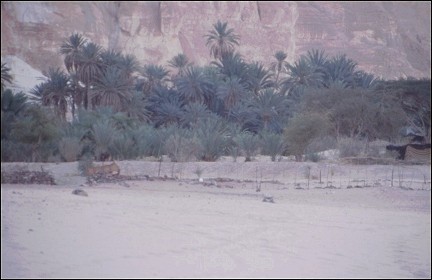
|
We stop at the White Canyon. A small canyon of a remarkably white color. We walk and clamber through it and at the end the camels are waiting to take us to an oasis.
The oasis is a beautiful green pearl in the desert. We have lunch here, a salad with canned fish and feta. We mount our camels again for a visit to Close Canyon. They mean it's narrow: during the last leg we have to take off our backpacks and walk sideways to get to the end.
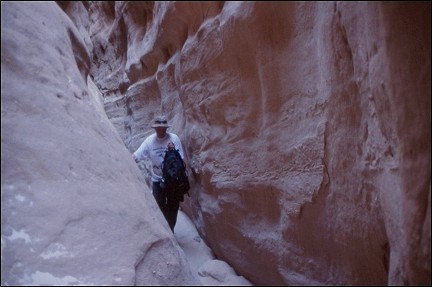
|
While we were hiking, our guides made tea. A small fire of brushwood heats the water quickly. They are really handy with this.
Back in the oasis dinner is cooked. Something with rice. Better in quantity than quality. For tonight we get warm blankets, fortunately, because I am afraid of the cold desert nights. But it doesn't get as cold here as it did on the Nile, so I sleep well.
Breakfast is baked on the spot. Balls of dough are beaten flat and the rusty lid of an old oil drum serves as baking tray. The camels are fed too. I am surprised to see that one of the camel drivers rips some cardboard boxes into pieces and feeds them to the camels, who eat them happily. If my stomach was that strong, I could eat pizzas with their boxes.
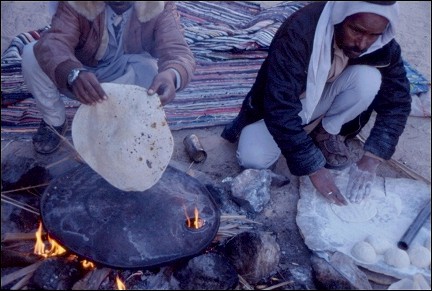
|
We constrict ourselves to freshly baked rolls and feta. Today we contiune to trudge through the desert. The landscape includes red rock walls formed by erosion.
Several kinds of green plants grow in the soft sand, despite the fact that it sometimes doesn't rain for 5 or 6 years. Some are large succulents but there are also small bushes with sharp thorns, which are eaten without any problem by the camels.
We also see a few small lizards. It doesn't matter how dry a climate is, there always is life. Also here, in the middle of nowehere, lunch is prepared on the spot. This time the dough goes on the hot sand and is covered with charcoal. When it's done, you sweep off the dust and the crust and your warm roll is ready to eat. In the afternoon we return to the highway; we will miss the silence of the desert.
Back to Cairo
As often in Egypt, there are many police checkpoints
We return to Cairo by bus. And as is often the case in Egypt, there are many police checkpoints on the way. When we arrive at the tunnel that runs below the Suez Canal, the bus is stopped and every passager has to show their passport. When everything is found to be in order, we are allowed to continue on our way to Cairo.
A rickety taxi takes us from the bus terminal to the New Garden Palace Hotel. We left the address of the this hotel with the air carrier as the place to take our luggage to in case it was found. To our amazement the luggage has arrived. Only four days ago. But still.
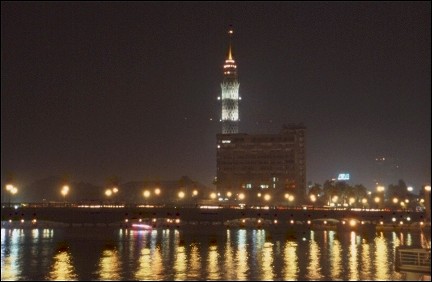
|
We have one day left to see Cairo. We visit the Egypt Museum for the second time and afterwards wander through shopping streets, where we are taken inside a papyrus shop and a perfum store. Both are wasted on us.
Our flight is supposed to leave at 3 AM, but again there is a delay: we have to wait 15 minutes for a few late passengers. Fortunately we still catch our connecting flight. Even the luggage makes it. This is the first time I return from vacation with a bag full of clean clothes...